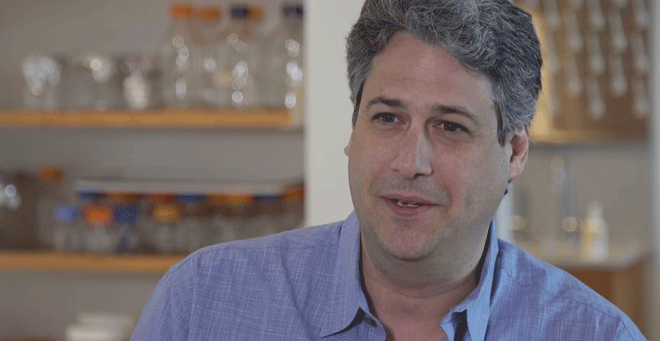It’s hard to pick a favorite story among all the great news we covered this year. So instead, we’re letting our readers pick. Here is one of the top five most-read stories published on UMassMedNow in 2016.
From the UMassMedNow editorial staff
 |
|
|
John Landers, PhD |
Variations in a gene with multiple functions in neurons are present in approximately 3 percent of all cases of ALS in North American and European populations, both sporadic and familial, making it one of the most common genetic causes of the disease, according to a paper published in Nature Genetics. Led by John Landers, PhD, professor of neurology at UMass Medical School and Jan Veldink, PhD, at University Medical Center Utrecht in the Netherlands, the research was supported by The ALS Association through Project MinE, an international collaboration for gene discovery in ALS, and funded through ALS Ice Bucket donations.
ALS (amyotrophic lateral sclerosis) is a progressive neurodegenerative disease that affects neurons in the brain and the spinal cord. Eventually, people with ALS lose the ability to initiate and control muscle movement, which often leads to total paralysis and death within two to five years of diagnosis. While 10 percent of ALS is familial, meaning it’s genetic, the other 90 percent of ALS cases are considered sporadic, or without a family history. However, it’s very likely that genetics contribute, directly or indirectly, to a much larger percentage of ALS cases.
The ALS Association announced funding for Project MinE, an international effort to sequence the genomes of at least 15,000 people with ALS, in October 2014, which established the U.S. arm of the initiative with Dr. Landers’ research efforts. Project MinE was the brainchild of entrepreneur Bernard Muller, and Robbert Jan Stuit, both of whom have ALS. They saw an opportunity to expedite genetic understanding of the disease after a tour of the Research ALS Center in the Netherlands where thousands of DNA samples are not being used because it was too expensive to do the research the center wanted to do.
“This study was only possible because of the collaboration of all of the scientists involved,” said Landers. “It is a prime example of the success that can come from the combined efforts of so many people, all dedicated to finding the causes of ALS. This kind of collaborative study is, more and more, where the field is headed.”
The study involved contributions from more than 80 researchers in 11 countries, and was the largest-ever study of familial ALS. Exome data from the familial ALS cases in the study have been added to the ALS Variant Server, a publicly available database funded by The ALS Association.
“The discovery of NEK1 highlights the value of big data in ALS research,” said Lucie Bruijn, PhD, MBA, of The ALS Association. “The sophisticated gene analysis that led to this finding was only possible because of the large number of ALS samples available. The ALS Ice Bucket Challenge enabled The ALS Association to invest in Project MinE’s work to create large biorepositories of ALS biosamples that are designed to allow exactly this kind of research and to produce exactly this kind of result.”
The new gene, called NEK1, was discovered through a genome-wide search for ALS risk genes in more than 1,000 ALS families, and was independently found through different means in an isolated population in the Netherlands. Further analysis in more than 13,000 sporadic ALS individuals compared to controls again revealed the overrepresentation of variants in the same gene. The variations discovered in the gene sequence are predicted to lead to a loss of function of the gene. NEK1 is known to have multiple roles in neurons, including maintenance of the cytoskeleton that gives the neuron its shape and promotes transport within the neuron. In addition, NEK1 has roles in regulating the membrane of the mitochondrion, which supplies energy to neurons, and in repairing DNA. Disruption of each of these functions through other means has been linked to increased risk of ALS.
Understanding the role of NEK1 in disease will provide an important new target for therapy development. The ALS Association is currently funding Landers and Catherine Lutz, PhD, senior research scientist at the Jackson Laboratories in Bar Harbour, Maine, to develop novel mouse models to better understand the consequences of the loss of the protein’s function for the ALS disease process. They will provide rapid access to these models for the broader ALS research community as soon as they are generated. These tools are important for ALS drug development.
Related stories on UMassMedNow:
UMMS-led discovery of ALS gene funded by Ice Bucket Challenge; nets global attention
Ice Bucket Challenge paying for genome sequencing in ALS patients
New ALS-associated gene identified using innovative strategy